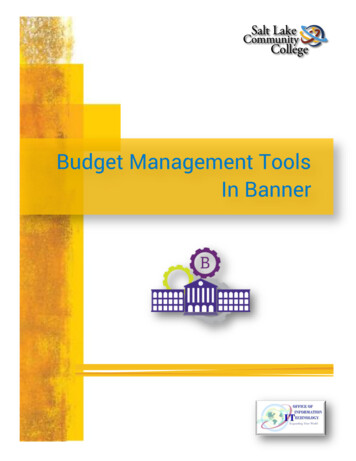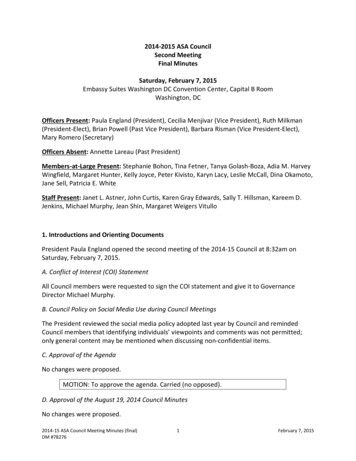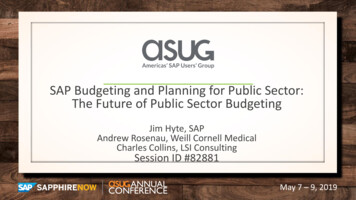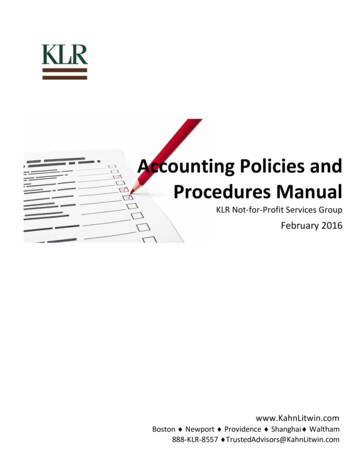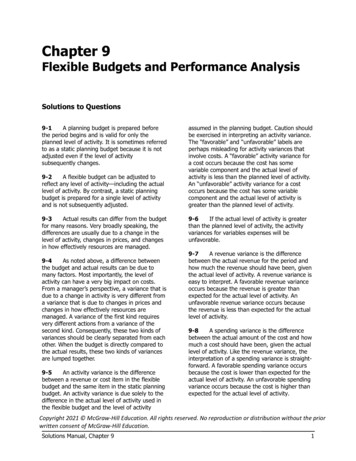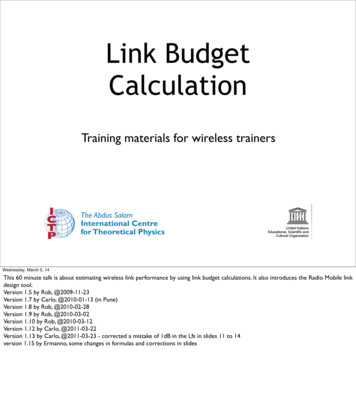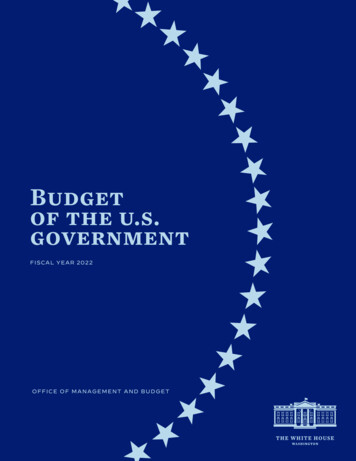
Transcription
Budgetof the u.s.governmentFISCAL YEAR 2022OF F ICE O F M A N AG E M E N T A N D B UDGET
Budgetof the u.s.governmentFISCAL YEAR 2022OFFICE OF MANAGEMENT AND BUDGET
THE BUDGET DOCUMENTSBudget of the United States Government,Fiscal Year 2022 contains the Budget Message ofthe President, information on the President’s priorities, and summary tables.Analytical Perspectives, Budget of the UnitedStates Government, Fiscal Year 2022 containsanalyses that are designed to highlight specifiedsubject areas or provide other significant presentations of budget data that place the budget in perspective. This volume includes economic and accountinganalyses, information on Federal receipts and collections, analyses of Federal spending, information onFederal borrowing and debt, baseline or current services estimates, and other technical presentations.Supplemental tables and other materialsthat are part of the Analytical Perspectives volume are available at /.Appendix, Budget of the United StatesGovernment, Fiscal Year 2022 contains detailedinformation on the various appropriations and fundsthat constitute the budget and is designed primarilyfor the use of the Appropriations Committees. TheAppendix contains more detailed financial information on individual programs and appropriationaccounts than any of the other budget documents.It includes for each agency: the proposed text ofappropriations language; budget schedules for eachaccount; legislative proposals; narrative explanations of each budget account; and proposed generalprovisions applicable to the appropriations of entireagencies or group of agencies. Information is alsoprovided on certain activities whose transactionsare not part of the budget totals.BUDGET INFORMATIONAVAILABLE ONLINEThe President’s Budget and supporting materialsare available online at https://whitehouse.gov/omb/budget/. This link includes electronic versions of allthe budget volumes, supplemental materials that arepart of the Analytical Perspectives volume, spreadsheets of many of the budget tables, and a public usebudget database. This link also includes HistoricalTables that provide data on budget receipts, outlays,surpluses or deficits, Federal debt, and Federal employment over an extended time period, generallyfrom 1940 or earlier to 2022 or 2026. Also availableare links to documents and materials from budgetsof prior years.For more information on access to electronic versions of the budget documents, call (202) 512-1530in the D.C. area or toll-free (888) 293-6498. To purchase the printed documents call (202) 512-1800.GENERAL NOTES1. All years referenced for budget data arefiscal years unless otherwise noted. Allyears referenced for economic data arecalendar years unless otherwise noted.2. Detail in this document may not add tothe totals due to rounding.U.S. GOVERNMENT PUBLISHING OFFICE, WASHINGTON 2021
Table of ContentsPageThe Budget Message of the President 1Confronting the Pandemic and Rescuing the Economy 5Building Back Better 9Delivering Results for All Americans through an Equitable, Effective,and Accountable Government 29Summary Tables 35OMB Contributors to the 2022 Budget 63
THE BUDGET MESSAGE OF THE PRESIDENTTo the Congress of the United States:Where we choose to invest speaks to what we value as a Nation.This year’s Budget, the first of my Presidency, is a statement of values that define our Nation atits best. It is a Budget for what our economy can be, who our economy can serve, and how we canbuild it back better by putting the needs, goals, ingenuity, and strength of the American people frontand center.The Budget is built around a fundamental understanding of how our economy works and why, fortoo long and for too many, it has not. It is a Budget that reflects the fact that trickle-down economicshas never worked, and that the best way to grow our economy is not from the top down, but fromthe bottom up and the middle out. Our prosperity comes from the people who get up every day, workhard, raise their family, pay their taxes, serve their Nation, and volunteer in their communities. Ifwe make that understanding our foundation, everything we build upon it will be strong.And we have already seen how that economic vision is working. When I took office, America wasa Nation in crisis. A once-in-a-century pandemic was raging, claiming thousands of American liveseach day. A punishing economic crisis had erased 22 million jobs in just 2 months in the spring of2020 and upended the lives of millions more. The pain these crises caused was visible not just in thedata, but in the lives of millions of Americans: Americans who faced an empty chair at the dinnertable where a loved one once sat; who had to shut down the family business; who lined up for milesin their cars waiting for a box of food to be put in the trunk; who went to bed staring at the ceilingwondering how they would get through tomorrow.Through the American Rescue Plan, we answered the emergency and provided desperately neededrelief to hundreds of millions of Americans. Immediately, the law began delivering shots in arms andchecks in pockets.The American Rescue Plan is also helping schools reopen safely, helping child care centers stayin business, and helping families pay for child care. In fact, it is providing the largest investmentin American child care since World War II. It is delivering food and nutrition assistance to millionsof Americans facing hunger. It is providing rental assistance to keep people from being evictedfrom their homes. It is helping small businesses and restaurants stay open or re-open. It is makinghealthcare more affordable. It is supporting the recovery of State and local governments. And it isputting us on track to cut child poverty in half this year.1
2The Budget Message of the PresidentWith the resources provided by the American Rescue Plan, we are turning the corner on thepandemic, and powering an equitable economic recovery. In my first 100 days in office, our economycreated more than 1.5 million jobs, the most in the first 100 days of any President on record. But morework remains—not simply to emerge from the immediate crises we inherited, but to build back better.The Budget lays out the essential investments that my Administration has proposed through theAmerican Jobs Plan and the American Families Plan.The American Jobs Plan puts millions of Americans to work to build our Nation back not just tothe way it was before the pandemic, but back better. Americans will rebuild America’s transportationinfrastructure, water infrastructure, and broadband connectivity infrastructure. Americans willbuild a clean energy future while investing in communities at risk of being left behind during ourenergy transition. American workers and American farmers will make unprecedented progress inour effort to tackle climate change. And, thanks to the biggest increase in non-defense research anddevelopment spending on record, Americans will boost America’s innovative edge in markets whereglobal leadership is up for grabs—markets like battery technology, biotechnology, computer chips, andclean energy. Finally, the American Jobs Plan will create new and better jobs for caregiving workerswho have been underpaid and undervalued for far too long.The American Families Plan addresses four of the biggest challenges facing American familiestoday, and lays the groundwork for individual, family, community, and national success tomorrow. Itguarantees four additional years of education for every American, beginning with 2 years of universalhigh-quality pre-school for every 3- and 4-year old in America, and adding 2 years of free communitycollege. It would make college more affordable and tackle equity gaps with increased Pell grants andinvestments in institutions serving low-income, first generation students, and students of color. Andit provides access to quality, affordable child care to low- and middle-income families, expanded accessto healthy meals because no child in America should be hungry or under-nourished, comprehensivepaid family and medical leave, and expanded game-changing tax credits for families and workers.The Budget complements these historic plans with additional proposals to reinvest in the foundationsof our Nation’s strength—expanding economic opportunity, improving education, tackling the climatecrisis, and ensuring a strong national defense while restoring America’s place in the world. In the1950s, our Department of Defense created a Defense Advanced Research Projects Agency (DARPA) toenhance our national security, and DARPA’s work helped lead to the creation of the internet, GlobalPositioning System, and more. The Budget would create an Advanced Research Projects Agency forHealth tasked with developing a new generation of medical breakthroughs—marshalling our Nation’sincredible scientific capacity to help prevent, detect, and treat diseases like cancer, diabetes, andAlzheimer’s. And it calls on the Congress to make progress on healthcare by cutting prescription drugcosts and expanding and improving the Affordable Care Act, Medicaid, and Medicare coverage.The Budget invests directly in the American people and will strengthen our Nation’s economyand improve our long-run fiscal health. It reforms our broken tax code to reward work instead ofwealth, while also fully paying for the American Jobs Plan and the American Families Plan over 15years. It will help us build a recovery that is broad-based, inclusive, sustained, and strong. And it willdemonstrate to the American people that we value them and that we recognize that they are the keyto our shared prosperity; that their Government sees them, hears them, and is able to deliver for themagain.
BUDGET OF THE U. S. GOVERNMENT FOR FISCAL YEAR 20223It will send to the world the message that I shared with a Joint Session of the Congress in April:that America is on the move again, and that our democracy is proving it can deliver for our people andis poised to win the competition for the 21st Century.There are many challenges ahead. But every time America has faced moments of testing, we haveemerged stronger. And I believe this Budget will help us become stronger than ever.I look forward to working with the Congress to deliver on this agenda this year.JOSEPH R. BIDEN, JR.The White House.
CONFRONTING THE PANDEMIC ANDRESCUING THE ECONOMYAmerica has always been defined by the gritand determination of its people, and our capacityto come together in common purpose at momentsof great challenge. Across the generations, thatspirit of resilience has seen us through war anddepression, natural disasters and disease, andcountless crises that have tested the Nation’sstrength, persistence, and commitment to corevalues and to one another. For more than a year,we have confronted a confluence of challengesthat have called on that resilience like neverbefore.Inheriting Historic ChallengesWhen the President took office, America wasin the grips of the worst pandemic in a centuryand a painful economic downturn that had upended virtually every aspect of American life. ByJanuary, more than 24 million Americans acrossthe Nation had contracted COVID-19. Infectionrates and hospitalizations were soaring. Morethan 400,000 Americans had lost their lives andthousands were dying every single day. A morecontagious variant of the virus had begun appearing in communities across America.Meanwhile, the Administration inherited adisorganized and ineffective national vaccinationeffort that was struggling to get off the ground.When the President took office, only eight percent of America’s seniors—and very few working-age adults—had received their first shot. Atthe same time, more than 10 months into theCOVID-19 pandemic, the Nation still lackedadequate testing capacity and faced shortagesof supplies like basic protective equipment forthose working on the frontlines.The broad failure to control the spread ofCOVID-19 in the months before the Presidenttook office had devastating and far-reachingconsequences. Millions of students and parents were forced to navigate the challengesof remote learning—straining countless families and disproportionately affecting Black,Hispanic, Asian, and Native American students, as well as students with disabilities andEnglish language learners. Disruptive changes in people’s daily lives also took a significant toll on both mental and physical health.Medically fragile individuals and those withchronic diseases such as hypertension, obesity, and diabetes had to make the decision toeither protect their health and avoid a negative outcome from COVID-19, or risk losingtheir jobs. More Americans reported experiencing symptoms of anxiety, overdose deathsrose, and domestic violence surged. Moreover,the COVID-19 pandemic exposed and exacerbated deeply rooted health inequities in theNation and laid bare gaps and weaknesses inAmerica’s public health infrastructure.As the virus tore across America, it left enormous economic damage in its wake. In January,more than 10 million Americans were out ofwork, with a national unemployment rate of6.3 percent. After accounting for workers whoeither dropped out of the labor force or couldnot find full-time work, the unemployment ratewas over 12 percent. More than 52 percent ofAmerica’s unemployed had been jobless formore than 15 weeks, a level of long-term unemployment unseen since the depths of the GreatRecession. In addition, 1 in 11 Black workersand 1 in 12 Latino workers were unemployed.5
6Confronting the Pandemic and Rescuing the EconomyThousands of small businesses closed theirdoors—many permanently—with many othersstruggling to stay afloat.Delivering Immediate Relief: Passingthe American Rescue Plan Act of 2021The jobs crisis was particularly severe amongwomen. When the President took office, a staggering 2.5 million women had dropped out ofthe labor force due to the COVID-19 pandemic—many to help care for their children, with potential lifetime consequences in terms of economicsecurity. Between February 2020 and January2021, the labor force participation rate for women dropped by 3.7 percent overall, 6.4 percent forBlack women, and 6.6 percent for Hispanic women, eviscerating more than 35 years of progressin labor force participation in just one year. Theeconomy was hit hardest in female dominated industries like retail and restaurants. On top of thejob loss in those sectors, women working on thefrontlines of the COVID-19 pandemic in nursinghomes and hospitals—many of whom are oftenlow-paid women of color—risked their health andscrambled to take care of their own families sothey could care for others. Early childhood andchild care providers—a significant share of whichare owned by women and people of color—havealso been devastated by the COVID-19 pandemic.Estimates suggest that among child care providers open at the beginning of the COVID-19 pandemic, as of December 2020, roughly one in fourwere closed.In the face of these twin public health and economic crises, the President took immediate, boldaction to deliver relief to the American people.The President proposed and signed into law theAmerican Rescue Plan Act of 2021 (the AmericanRescue Plan)—a historic, comprehensive package designed to help change the course of theCOVID-19 pandemic, deliver desperately needed support to millions of workers, families, andsmall businesses, and build a bridge to a robust,equitable economic recovery.As a result of this enormous economic disruption, countless Americans who were financiallystretched even before the COVID-19 pandemicwere plunged into an economic emergency. Onein three households struggled to afford basicexpenses. Millions of households reported nothaving enough to eat. Millions of Americansfell behind on their rent or mortgage payments,with more than 15 million households reporting overdue payments when the President tookoffice. Roughly two to three million people lostemployer sponsored health insurance betweenMarch and September. Further, going into theCOVID-19 pandemic, about 30 million peoplelacked coverage, limiting their access to thehealthcare system when the COVID-19 pandemic struck.The American Rescue Plan advanced threecritical priorities. First, it included urgentlyneeded resources to help families and businessesweather the worst of the COVID-19 pandemic,including: 1,400 per-person rescue paymentsfor households across America; extended unemployment insurance; housing and nutrition assistance; increased access to safe and reliablechild care and affordable healthcare; historicexpansions of middle class tax relief for working families; a solution to the crisis in America’smulti-employer pension system; and support forhard-hit small businesses. Second, it provided vital resources to help safely reopen K-8 schools incommunities across the Nation and address theneeds of students. Third, it provided resources tohelp mount an unprecedented Government-wideeffort to defeat the COVID-19 pandemic, including funding to: set up community vaccinationsites nationwide; dramatically scale up testingand tracing; eliminate supply shortage problems;support community health centers; and addresshealth disparities.The resources included in the American RescuePlan, coupled with the President’s whole-of-Government response, have already begun to changethe course of the COVID-19 pandemic and bolster the economy. In a matter of months, theAdministration turned the slow-moving and underperforming vaccination effort it inherited intoone of the most effective vaccination systems anywhere in the world. The Administration exceeded
BUDGET OF THE U. S. GOVERNMENT FOR FISCAL YEAR 2022the President’s initial goal of administering100 million shots in his first 100 days, ultimatelyadministering 220 million shots in the President’sfirst 100 days in office—an unprecedented national mobilization. As of May 17, nearly 60 percentof American adults had received at least one shot;nearly 85 percent of all seniors had received atleast one shot and nearly 73 percent were fullyvaccinated; and daily deaths were down morethan 80 percent since January 20. All Americans12 and older are now eligible for a COVID-19vaccine. In addition, the Administration metthe President’s goal to reopen a majority of K-8schools within the first 100 days.As the Administration has ramped up the national COVID-19 pandemic response, the economyhas started to get back on track. The Presidentoversaw the creation of more than 1.5 millionnew jobs in his first 100 days in office—more thanany president on record. Economists have raisedtheir Gross Domestic Product growth forecastsfor 2021 to 6.6 percent, which would be the fastest pace of economic growth in America in nearlyfour decades. Consumer confidence and spendingare on the rise. Business activity is rebounding.Moreover, the Administration is ensuring theAmerican Rescue Plan reaches families, communities, and small businesses. The Department ofthe Treasury has already delivered more than165 million relief payments of up to 1,400 perperson. The American Rescue Plan is deliveringnutrition assistance to millions of Americans facing hunger, rental assistance and mortgage reliefto help families stay in their homes, and loans tosmall businesses to help keep their doors open. Itincludes the largest investment in child care sinceWorld War II, which will especially benefit women of color. It is reducing healthcare premiums,expanding access to insurance coverage, and addressing persistent health disparities. It ensuresthat millions of American workers and retireeswill receive the pensions they earned. In addition,7it is projected to reduce poverty by 32 percent,lifting a total of nearly 13 million Americans outof poverty—this would mean a 38-percent dropin the Black poverty rate, a 43-percent drop inthe Hispanic poverty rate, a 23-percent drop inthe Asian American and Pacific Islander povertyrate, and a 50-percent drop in the child povertyrate.Emerging from Crises andFocusing on the FutureWhile significant challenges remain, theAmerican Rescue Plan has succeeded by virtually every measure in helping address the immediate economic and public health crises theAdministration inherited. However, even as theAdministration makes significant strides to getthe Nation back on track, the President believesit is not enough to go back to the way things werebefore the COVID-19 pandemic struck, or to settle for a shrunken view of what America can be.The President believes this is a moment to buildback better and to rise to meet the full range ofchallenges and opportunities before us—from rebuilding America’s crumbling physical and careinfrastructure and creating millions of good-paying jobs, to combatting climate change and revitalizing American manufacturing, to expandingaccess to both early childhood and higher education and addressing systemic inequities, andmore.None of this work will be easy. Many of the challenges America faces have been years or decadesin the making. These challenges do not lend themselves to quick or easy solutions, nor will they befully resolved in a single year or with a single budget. But it is precisely at the moments of greatestconsequence that Americans have shown their capacity to think big and do the hard work of charting a new and better course for the future. Ourcharge now is to carry that legacy forward.
BUILDING BACK BETTERUnder the President’s leadership, America isgetting back on track. We have begun turningthe tide on the pandemic. Our economy is growing and creating jobs. Students are getting backinto classrooms. And we have shown yet againthere is no quit in America. But our work hasonly begun.For all of the hard-won progress our Nationhas made in recent months, we cannot afford tosimply return to the way things were before thepandemic and economic downturn, with the oldeconomy’s structural weaknesses and inequitiesstill in place. We must seize this moment to reimagine and rebuild a new American economy—an economy that invests in the promise and potential of every single American; that leaves noone out and no one behind; and that makes iteasier for families to break into the middle classand stay in the middle class.The Budget details the President’s proposalsto advance that agenda this year. It includesthe two historic plans the President has alreadyput forward—the American Jobs Plan and theAmerican Families Plan—and outlines a package of discretionary proposals to help restorecore functions of Government and reinvest inthe foundations of the Nation’s strength. It alsocalls on the Congress to reduce prescription drugcosts and expand and improve health coverage.Enacting the Budget policies into law this yearwould strengthen our Nation’s economy andlay the foundation for shared prosperity, whilealso putting the Nation on a sound fiscal course.Importantly, even as the Administration pursues this historic agenda, the President also believes that there will be more to accomplish inthe coming years. This year’s Budget gives a fullaccounting of the first, critical steps our Nationmust take to begin the work of building backbetter.The American Jobs PlanThe Budget begins with the American JobsPlan—an investment in America that would create millions of good jobs, rebuild the Nation’s infrastructure, and position the United States toout-compete China. Public domestic investmentas a share of the economy has fallen by morethan 40 percent since the 1960s. The AmericanJobs Plan would invest in America in a way thathas not occurred since the interstate highwayswere built and the Space Race was won.The United States is the wealthiest Nation inthe world, yet ranks 13th when it comes to theoverall quality of the Nation’s infrastructure.After decades of disinvestment, America’s roads,bridges, and water systems are crumbling. Theelectric grid is vulnerable to catastrophic outages. Too many lack access to affordable, highspeed internet and to quality housing. The pastyear has led to job losses and threatened economic security, eroding more than 30 years of progress in women’s labor force participation. It hasunmasked the fragility of America’s caregivinginfrastructure. In addition, the Nation is fallingbehind its biggest competitors in research anddevelopment (R&D), manufacturing, and training. It has never been more important to investin strengthening the Nation’s infrastructure andcompetitiveness, and in creating the good-paying, union jobs of the future.9
10As with great projects of the past, thePresident’s plan would unify and mobilize theNation to meet the great challenges of our time:the climate crisis and the ambitions of an autocratic China. It would invest in Americans anddeliver the jobs and opportunities they deserve.Unlike past major investments, the plan prioritizes addressing long-standing and persistentracial injustice. The plan targets 40 percent ofthe benefits of climate and clean infrastructureinvestments to disadvantaged communities. Inaddition, the plan invests in rural communitiesand communities impacted by the market-basedtransition to clean energy. Specifically, thePresident’s plan:Fixes Highways, Rebuilds Bridges, andUpgrades Ports, Airports, and TransitSystems. The President’s plan would: modernize 20,000 miles of highways, roads, and mainstreets; fix the 10 most economically significantbridges in the Nation in need of reconstruction;repair the worst 10,000 smaller bridges, providing critical linkages to communities; replacethousands of buses and rail cars; repair hundredsof stations; renew airports; modernize ports ofentry; and expand transit and rail into newcommunities.Delivers Clean Drinking Water, a RenewedElectric Grid, and High-Speed Broadbandto All Americans. The President’s plan wouldeliminate all lead pipes and service lines indrinking water systems, improving the health ofthe Nation’s children and communities of color.It would put hundreds of thousands of people towork laying thousands of miles of transmissionlines and capping hundreds of thousands of orphan oil and gas wells and abandoned mines. Itwould also bring affordable, reliable, high-speedbroadband to every household, including themore than 35 percent of rural families who lackaccess to broadband infrastructure, the millionsof families paying too much for broadband, andthe millions of low-income and marginalized communities left behind by digital redlining and thedigital divide.Building Back BetterBuilds, Preserves, and Retrofits Morethan Two Million Homes and CommercialBuildings, Modernizes the Nation’s Schoolsand Child Care Facilities, and UpgradesVeterans’ Hospitals and Federal Buildings.The President’s plan would create good jobs bybuilding, rehabilitating, and retrofitting affordable, accessible, energy efficient, and resilienthousing, commercial buildings, schools, and childcare facilities all over the Nation while also vastly improving the Nation’s Federal facilities, especially those that serve veterans.Solidifies the Infrastructure of America’sCare Economy by Creating Jobs and RaisingWages and Benefits for Essential Home CareWorkers. These workers—the majority of whomare women of color—have been underpaid andundervalued for too long. The President’s planmakes substantial investments in the infrastructure of America’s care economy, starting by creating new and better jobs for caregiving workers. Itwould provide home and community-based carefor individuals who otherwise would need to waitas many as five years to get the services theybadly need. The President also looks forward toworking with the Congress on other policies toimprove economic security and access to healthcare for seniors and people with disabilities.Revitalizes Manufacturing, Secures U.S.Supply Chains, Invests in R&D, and TrainsAmericans for the Jobs of the Future. ThePresident’s plan would ensure that the best, diverse minds in America are put to work creating the innovations of the future while creating hundreds of thousands of quality jobs today.American workers would build and make thingsin every part of the Nation, and they would betrained for well-paying, middle-class jobs usingevidence-based approaches such as sector-basedtraining and registered apprenticeships.Creates Good-Quality Jobs that PayPrevailing Wages in Safe and HealthyWorkplaces while Ensuring Workers Havea Free and Fair Choice to Organize, Join a
BUDGET OF THE U. S. GOVERNMENT FOR FISCAL YEAR 2022Union, and Bargain Collectively with TheirEmployers. To ensure that American taxpayers’dollars benefit working families and their communities, and not multinational corporations orforeign governments, the plan requires that goodsand materials are made in America and shippedon U.S.-flag, U.S.-crewed vessels. The plan alsowould ensure that Americans, especially thosewho have endured systemic discrimination andexclusion for generations, finally have a fair shotat obtaining good-paying jobs with: a choiceto join a union; higher and equal pay; safe andhealthy workplaces; and workplaces free fromracial, gender, and other forms of discriminationand harassment.Restructures the Corporate Tax Codeto Ensure that Wealthy Corporations PayTheir Fair Share and Invest Here at Home.Alongside the American Jobs Plan, the Presidenthas put forward a Made in America tax
Budget of the United States Government, Fiscal Year 2022. contains the Budget Message of . . contagious variant of the virus had begun
